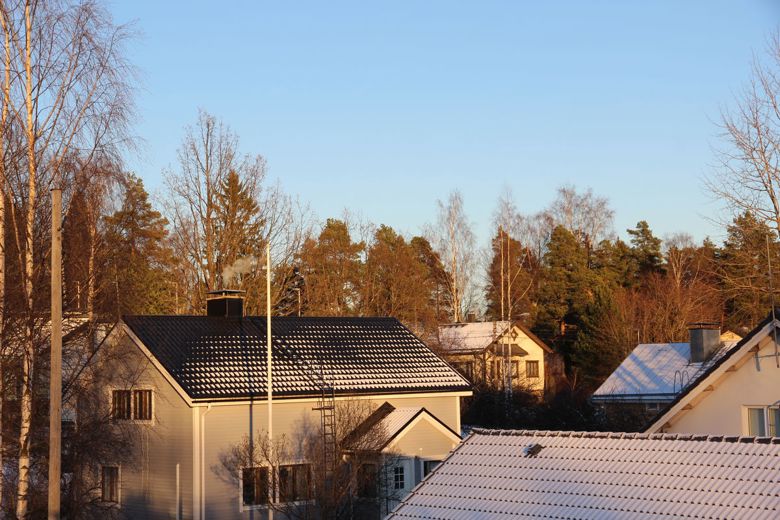Wood burning reduces air quality

Wood is burned in approximately 80% of the detached houses in the Helsinki metropolitan area. Even though the use of wood as the primary heating method is rare in the Helsinki metropolitan area, wood burning is of great significance as there are many detached houses close together. The emissions from wood burning have a significant impact on people’s health, as they are generated in residential areas and released into the breathing air of the surrounding environment. The use of fireplaces is concentrated on times when people are at home or in their yard, and are thus exposed to the emissions. On days with freezing weather and little wind, the smoke will hang in the air in the yard and find its way into homes.
The use of fireplaces generates smoke, i.e. emissions into the air. Harmful emissions are generated especially if waste or wet wood is burned. The emissions from poor combustion are many times higher than those from the skilful burning of dry wood in a good fireplace. The emissions include particles, carbon monoxide, hydrocarbons and black carbon, as well as polycyclic aromatic compounds, such as benzo(a)pyrene. These are harmful to human health and also reduce comfort. In addition, black carbon is a pollutant that accelerates climate change, and black carbon emissions, particularly from northern latitudes, travel to glaciers and speed up their melting process.
Wood burning is not going to be banned. However, everyone can influence how cleanly wood burns. The most important thing is to only burn dry wood – not rubbish or wet wood. Even an old fireplace can be used skillfully, reducing the amount of pollutants formed. It is also important to ensure adequate availability of supply air. Poor combustion and especially burning wood with insufficient air produces a lot of smoke. This undermines peace between neighbours, but is also a health hazard in dense detached housing areas. Fine particles in smoke increase respiratory and cardiac symptoms, for example. Long-term exposure has been shown to increase morbidity and premature mortality. The EU has set a target value for the carcinogenic benzo(a)pyrene in outdoor air (1 nanogram per cubic metre of air), which is not recommended to be exceeded.
Information on the acquisition, storage and use of firewood, as well as on sauna heating, has been compiled comprehensively at poltapuhtaasti.fi (Burn Wood Cleanly). The website also contains information on projects and events related to wood burning. Brochures and videos on wood burning have been compiled on the site. Brochures can also be ordered from HSY: hsy.fi/esitteet.
Tips for burning wood with lower emissions
- Store wood dry and in a ventilated woodshed.
- Use only dry and clean wood in the fireplace. Do not burn waste, recyclable material or painted, glued or impregnated wood. Waste incineration is prohibited by municipal environmental protection regulations and waste management regulations. Small splinters or fire starter sticks are the best for lighting a fire as well. Check the waste guide for sorting instructions.
- Avoid burning wood with insufficient air. Good combustion requires sufficient air.
- Light the fireplace correctly. Emissions can also be influenced by fire starting methods. The most emissions are generated when lighting and in the early stages of the fire. In most fireplaces, lighting it from the top, i.e. placing the kindling on top of the firewood, has proved to be the best way to light a fire. In this case, the wood takes fire from the heat of the kindling, and everything that gasifies also burns. If cold wood chips are heated from below, they will gasify, but not burn completely. This generates a large amount of emissions.
- Monitor the colour of the smoke coming from the chimney. The lighter the smoke, the cleaner the wood burns. The colour of the smoke should become lighter shortly after lighting the fire.
- Take care of regular chimney sweeping. You can also ask your chimney sweeper for tips on wood burning.
Weather affects the spread of smoke
If the weather is cold or there is little wind, emissions will hang in the air over a low detached housing area and penetrate into the homes as well. The spread and dilution of smoke is influenced by wind direction and speed, general weather conditions, the location of buildings, and the height of the chimney. Smoke causes the most problems in densely built detached housing areas.
If you are bothered by smoke from a neighbour
The burning of wood or other solid fuels in fireplaces must not cause undue harm to neighbours or the surrounding environment. If you are bothered by smoke from a neighbour, you should talk to that neighbour. Maybe they just have not come to think that the smoke would bother others. If talking does not help, contact the environmental or health protection authority of your municipality. They will look into it and give advice if needed.